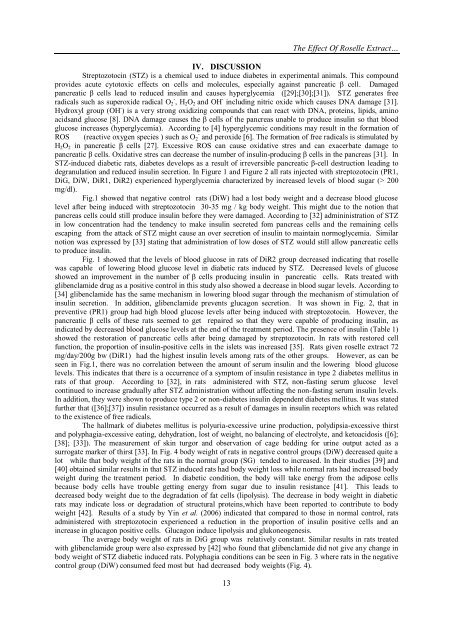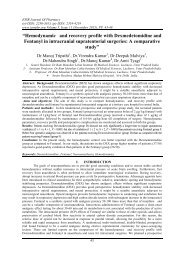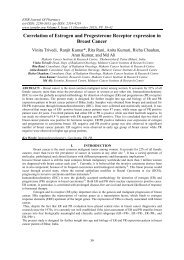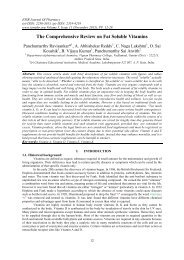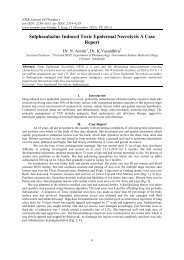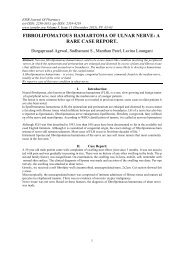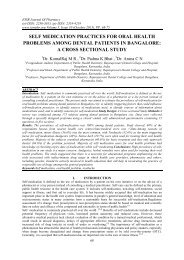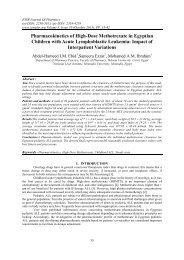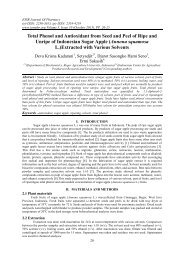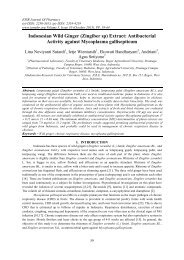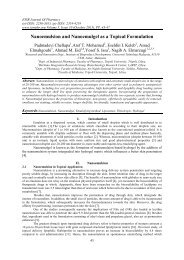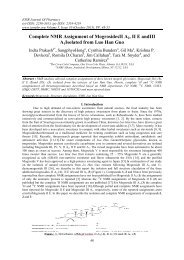The Effect Of Roselle Extract (Hibiscus Sabdariffa Linn.) On Blood Glucose Level And Total Antioxidant Level On Diabetic Rat Induced By Streptozotocin
Create successful ePaper yourself
Turn your PDF publications into a flip-book with our unique Google optimized e-Paper software.
13<br />
<strong>The</strong> <strong>Effect</strong> <strong>Of</strong> <strong>Roselle</strong> <strong>Extract</strong>…<br />
IV. DISCUSSION<br />
<strong>Streptozotocin</strong> (STZ) is a chemical used to induce diabetes in experimental animals. This compound<br />
provides acute cytotoxic effects on cells and molecules, especially against pancreatic β cell. Damaged<br />
pancreatic β cells lead to reduced insulin and causes hyperglycemia ([29];[30];[31]). STZ generates free<br />
radicals such as superoxide radical O - 2 , H 2 O 2 and OH - including nitric oxide which causes DNA damage [31].<br />
Hydroxyl group (OH - ) is a very strong oxidizing compounds that can react with DNA, proteins, lipids, amino<br />
acidsand glucose [8]. DNA damage causes the β cells of the pancreas unable to produce insulin so that blood<br />
glucose increases (hyperglycemia). According to [4] hyperglycemic conditions may result in the formation of<br />
ROS (reactive oxygen species ) such as O - 2 and peroxide [6]. <strong>The</strong> formation of free radicals is stimulated by<br />
H 2 O 2 in pancreatic β cells [27]. Excessive ROS can cause oxidative stres and can exacerbate damage to<br />
pancreatic β cells. Oxidative stres can decrease the number of insulin-producing β cells in the pancreas [31]. In<br />
STZ-induced diabetic rats, diabetes develops as a result of irreversible pancreatic β-cell destruction leading to<br />
degranulation and reduced insulin secretion. In Figure 1 and Figure 2 all rats injected with streptozotocin (PR1,<br />
DiG, DiW, DiR1, DiR2) experienced hyperglycemia characterized by increased levels of blood sugar (> 200<br />
mg/dl).<br />
Fig.1 showed that negative control rats (DiW) had a lost body weight and a decrease blood glucose<br />
level after being induced with streptozotocin 30-35 mg / kg body weight. This might due to the notion that<br />
pancreas cells could still produce insulin before they were damaged. According to [32] admininistration of STZ<br />
in low concentration had the tendency to make insulin secreted fom pancreas cells and the remaining cells<br />
escaping from the attack of STZ might cause an over secretion of insulin to maintain normoglycemia. Similar<br />
notion was expressed by [33] stating that administration of low doses of STZ would still allow pancreatic cells<br />
to produce insulin.<br />
Fig. 1 showed that the levels of blood glucose in rats of DiR2 group decreased indicating that roselle<br />
was capable of lowering blood glucose level in diabetic rats induced by STZ. Decreased levels of glucose<br />
showed an improvement in the number of β cells producing insulin in pancreatic cells. <strong>Rat</strong>s treated with<br />
glibenclamide drug as a positive control in this study also showed a decrease in blood sugar levels. According to<br />
[34] glibenclamide has the same mechanism in lowering blood sugar through the mechanism of stimulation of<br />
insulin secretion. In addition, glibenclamide prevents glucagon secretion. It was shown in Fig. 2, that in<br />
preventive (PR1) group had high blood glucose levels after being induced with streptozotocin. However, the<br />
pancreatic β cells of these rats seemed to get repaired so that they were capable of producing insulin, as<br />
indicated by decreased blood glucose levels at the end of the treatment period. <strong>The</strong> presence of insulin (Table 1)<br />
showed the restoration of pancreatic cells after being damaged by streptozotocin. In rats with restored cell<br />
function, the proportion of insulin-positive cells in the islets was increased [35]. <strong>Rat</strong>s given roselle extract 72<br />
mg/day/200g bw (DiR1) had the highest insulin levels among rats of the other groups. However, as can be<br />
seen in Fig.1, there was no correlation between the amount of serum insulin and the lowering blood glucose<br />
levels. This indicates that there is a occurrence of a symptom of insulin resistance in type 2 diabetes mellitus in<br />
rats of that group. According to [32], in rats administered with STZ, non-fasting serum glucose level<br />
continued to increase gradually after STZ administration without affecting the non-fasting serum insulin levels.<br />
In addition, they were shown to produce type 2 or non-diabetes insulin dependent diabetes mellitus. It was stated<br />
further that ([36];[37]) insulin resistance occurred as a result of damages in insulin receptors which was related<br />
to the existence of free radicals.<br />
<strong>The</strong> hallmark of diabetes mellitus is polyuria-excessive urine production, polydipsia-excessive thirst<br />
and polyphagia-excessive eating, dehydration, lost of weight, no balancing of electrolyte, and ketoacidosis ([6];<br />
[38]; [33]). <strong>The</strong> measurement of skin turgor and observation of cage bedding for urine output acted as a<br />
surrogate marker of thirst [33]. In Fig. 4 body weight of rats in negative control groups (DiW) decreased quite a<br />
lot while that body weight of the rats in the normal group (SG) tended to increased. In their studies [39] and<br />
[40] obtained similar results in that STZ induced rats had body weight loss while normal rats had increased body<br />
weight during the treatment period. In diabetic condition, the body will take energy from the adipose cells<br />
because body cells have trouble getting energy from sugar due to insulin resistance [41]. This leads to<br />
decreased body weight due to the degradation of fat cells (lipolysis). <strong>The</strong> decrease in body weight in diabetic<br />
rats may indicate loss or degradation of structural proteins,which have been reported to contribute to body<br />
weight [42]. Results of a study by Yin et al. (2006) indicated that compared to those in normal control, rats<br />
administered with streptozotocin experienced a reduction in the proportion of insulin positive cells and an<br />
increase in glucagon positive cells. Glucagon induce lipolysis and glukoneogenesis.<br />
<strong>The</strong> average body weight of rats in DiG group was relatively constant. Similar results in rats treated<br />
with glibenclamide group were also expressed by [42] who found that glibenclamide did not give any change in<br />
body weight of STZ diabetic induced rats. Polyphagia conditions can be seen in Fig. 3 where rats in the negative<br />
control group (DiW) consumed feed most but had decreased body weights (Fig. 4).


